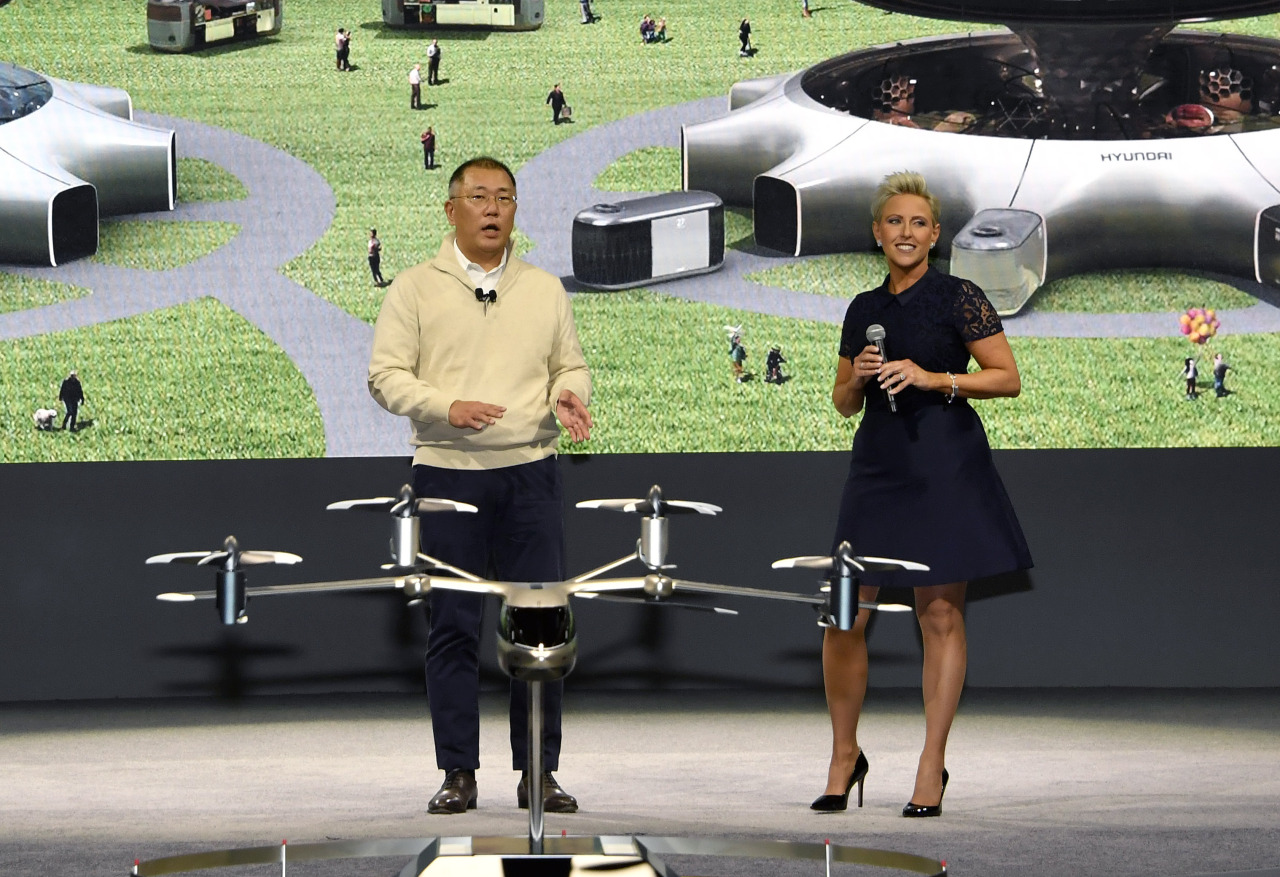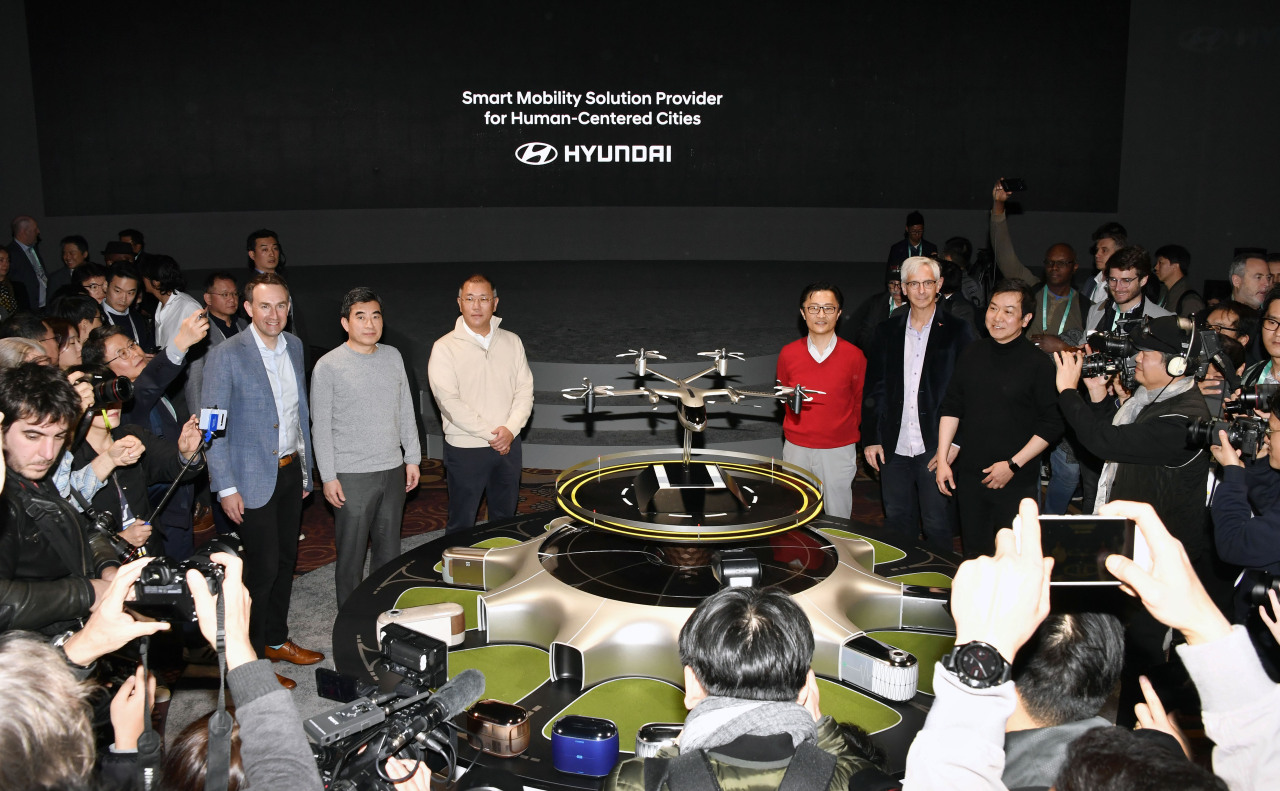[CES 2020] Hyundai foresees personal air vehicle by 2028
Hyundai Motor chief Chung Euisun vows to disrupt concept of transport with smart mobility
By Kim Da-solPublished : Jan. 7, 2020 - 16:00
Hyundai Motor envisions a future of mobility where people can hop on a personal air vehicle and transfer to a specialized vehicle that doubles as a restaurant or even a clinic, its chief said Monday.
Speaking at the annual Consumer Electronics Show in Las Vegas, Hyundai Motor Group Executive Vice Chairman Chung Euisun unveiled a smart mobility vision for hubs that link aerial vehicles with specialized ground transportation.
Speaking at the annual Consumer Electronics Show in Las Vegas, Hyundai Motor Group Executive Vice Chairman Chung Euisun unveiled a smart mobility vision for hubs that link aerial vehicles with specialized ground transportation.

“We have thought deeply about what is significant when it comes to human life in the city,” he said. “Hyundai Motor will contribute to shaping a human-centered future city where barriers between cities are broken down, people can achieve their goals effectively and form new communities through reduced transportation times.”
In its quest to depart from the industry convention of four-wheels, South Korea’s largest automaker has been highlighting its efforts to transform into a provider of smart mobility devices and services.
The vision will be implemented through three main solutions of urban air mobility (UAM), purpose built vehicles (PBV) and mobility hubs, according to Chung.
“CES is just a starting point (for Hyundai Motor to achieve such determination) and we will continue to put effort into actualizing that vision,” Chung added.
The company explained while UAM will connect land to air, PBV will connect people to people on the road. These two types of smart mobility will form a connected mobility ecosystem through the “hubs.”
The first of the three solutions, UAM, intends to use private air vehicles, which the company refers to as PAVs.
“UAM will free people from traffic on the road and create meaningful time for people to spend time on valuable, meaningful activities,” said Shin Jae-won, chief of the UAM business division at Hyundai Motor.
And its concept of UAM will make use of electric vertical take-off and landing systems to move around the city without having to use runways.
Putting safety as a priority, Hyundai Motor said the construction of UAVs will be based on low noise design, while being equipped with the latest internet of things technology. It also added that by making use of its knowhow as a vehicle manufacturer, it will keep the cost competitive.
The executive vice chairman said that the project would be undertaken not only in the overseas market but also in Korea, while it will need “close cooperation with the local government considering regulations.” To a question of when it would be commercialized, Chung said he envisioned it “by 2028.”
Kim Sang-do, an official from the Transport Ministry told reporters at CES 2020 that the government is aware of the significance of UAM and “believes 2020 is an important year for the realization of UAM.”
Adding that the government will support infrastructure and product approval for UAM commercialization, Kim said safety will be the top concern, and that it has been working with governments in other countries and aviation authorities to discuss regulation and safety.
As for PBVs, they will be customized, eco-friendly mobility solutions, the automaker said.
“The design DNA of PBV has been inspired from San Francisco’s landmark cable car,” said Lee Sang-yeob, a head of design center at Hyundai Motor. Based on the purpose of the vehicle, PBVs can be expanded up to 6 meters from the standard 4-meter length.
The interior of a PBV can be customized, meaning that it not only serves as a city shuttle, but also as a restaurant, cafe, hotel or even a hospital or pharmacy, according to the automaker.
Hyundai Motor likened its hub concept to a bus station, but one that connects UAM and PBV.
Based on the blueprint, a vertical landing and takeoff area for personal air vehicles will be located on the roof of a hub, while the first floor will have docking stations for PBVs. Different types of PBVs and form a community, for example, when PBVs of medical services such dental clinics or pharmacies combine with a hub, the hub can become a hospital.
As a visual example, Hyundai Motor unveiled the first concept car for PAV called S-A1, in collaboration with Uber.

S-A1 can seat five passengers including a driver. It runs on electricity and operates vertical landing and takeoff functions.
The automaker said although the first-stage models will need human drivers, in the long term they will be developed to operate based on autonomous driving.
“We believe when Hyundai Motor’s manufacturing capacity synergizes with Uber’s technology platform, we can make a big leap in achieving a city air network,” said Eric Allison, chief of Uber Elevate.
Hyundai Motor also showcased life-size S-Link, a concept PBV and S-Hub, a concept hub at CES 2020 which runs until Friday.
By Kim Da-sol (ddd@heraldcorp.com)







![[KH Explains] Hyundai's full hybrid edge to pay off amid slow transition to pure EVs](http://res.heraldm.com/phpwas/restmb_idxmake.php?idx=644&simg=/content/image/2024/04/18/20240418050645_0.jpg&u=20240419100350)







![[From the Scene] Monks, Buddhists hail return of remains of Buddhas](http://res.heraldm.com/phpwas/restmb_idxmake.php?idx=652&simg=/content/image/2024/04/19/20240419050617_0.jpg&u=20240419175937)

![[KH Explains] Hyundai's full hybrid edge to pay off amid slow transition to pure EVs](http://res.heraldm.com/phpwas/restmb_idxmake.php?idx=652&simg=/content/image/2024/04/18/20240418050645_0.jpg&u=20240419100350)

![[Today’s K-pop] Illit drops debut single remix](http://res.heraldm.com/phpwas/restmb_idxmake.php?idx=642&simg=/content/image/2024/04/19/20240419050612_0.jpg&u=)